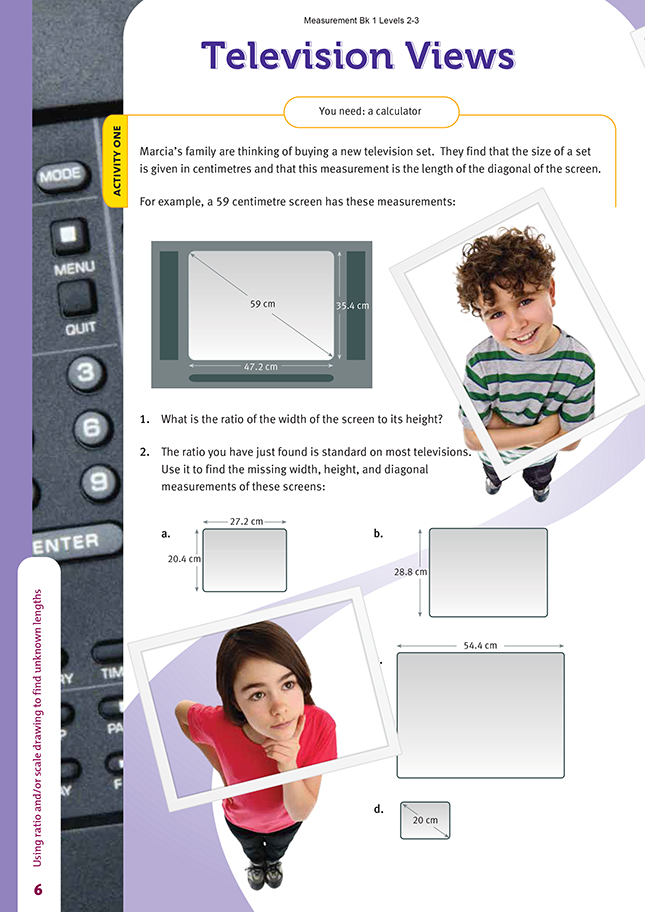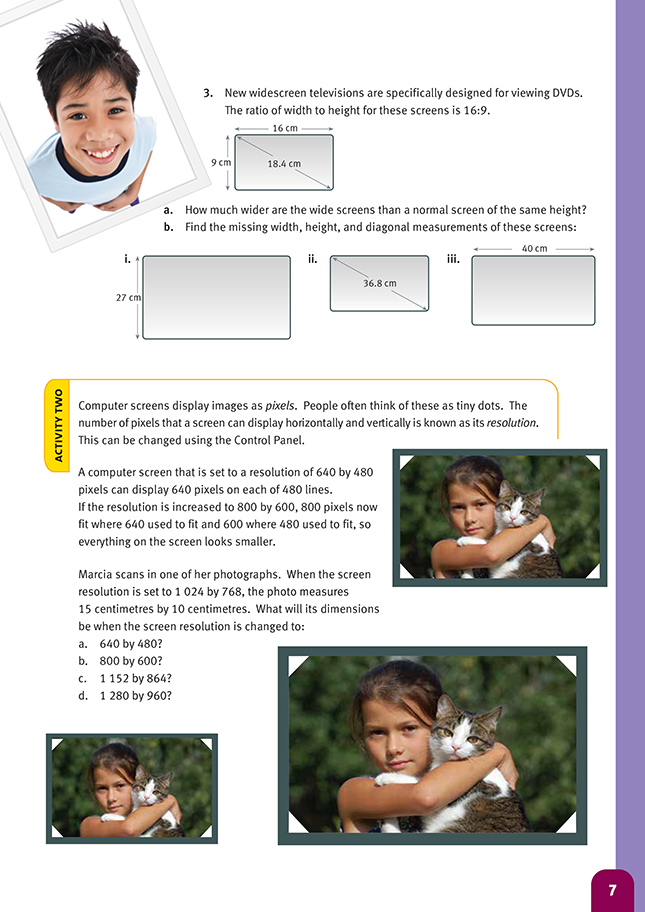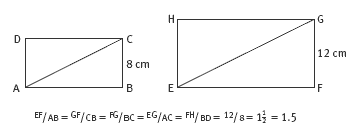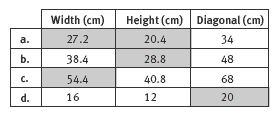This is a level 5 measurement strand activity from the Figure It Out series. It also has an achievement objective from the Level 5 Number strategies and knowledge substrand.
A PDF of the student activity is included.
Click on the image to enlarge it. Click again to close. Download PDF (368 KB)
use ratios to find unknown lengths
FIO, Level 4+, Measurement, Book Two, Television Views, pages 6-7
calculator
Activity One
This activity is about using ratio to find the missing dimensions of similar shapes.
The key concepts here are:
- Similarity. In normal usage, this word means that two things resemble each other, usually in some vague and unspecified way. In mathematics, it means that two shapes are identical in all respects except for size (in other words, one is an enlarged version of the other).
- Ratio. When two figures are similar, a comparison of any pair of corresponding sides will give the same ratio (in other words, the scale factor of the enlargement). Corresponding sides are "matching" sides. To find the ratio for two similar figures, you must first find two corresponding sides for which the measurements are known. The diagram illustrates this principle:
In other words, every length in the second rectangle (whether drawn in or not) is 1.5 times the corresponding length in the first rectangle. Working in reverse, every length in the first rectangle is 2/3 (8/12) of the length in the second rectangle.
Note that there are many other internal comparisons that can also be made. For the above example, these include:
Such comparisons can often be used to help solve problems, but they do not give the scale factor.
The diagrams in questions 2 and 3 have been drawn to scale, so students who are unfamiliar with ratio may solve the questions by measurement. However, if they use this method, they will learn nothing new from the activity.
Two of the questions, 2d and 3b ii, involve working with the lengths of diagonals, and it may look as if Pythagoras' theorem is needed, but it is not. The students can use ratio to solve question 2d by comparing the length of the diagonal (20) with the length of the diagonal in the example at the top of the page (59) to get the ratio 20/59 = 0.339. The width and height of the screen in question 2d can now be found by multiplying the width and height in the example (47.2 and 35.4) by 0.339. Question 3b ii can be solved mentally by noting that the diagonal (36.8) is exactly twice the length of the diagonal in the example at the start of question 3 (18.4). So the width and height of 3b ii are twice those dimensions in the example.
Activity Two
In this activity, the students discover that the on-screen dimensions of a photograph grow when the screen resolution is reduced and shrink when the screen resolution is increased. This is an example of an inverse relationship (one variable is increased when another is decreased). Discuss other examples of inverse relationships with your class, for example, the speed-time relationship (when speed increases, time decreases).
When doing tasks of this kind, the students should ask themselves whether they should get an increase or a decrease. If they expect an increase, their ratio should have the larger number on top. If they expect a decrease, their ratio should have the smaller number on top. At the original resolution of 1024 by 768, the photo is 15 centimetres long. If the resolution is reduced to 640 by 480, the screen size of the photo is increased (as explained by the text), so the ratio is 1024/640 (or 768/480), and the screen length of the photo becomes 15 x 1024/640 = 24 centimetres (the original length multiplied by the scale factor).
Cross-curricular links
This activity could be part of a unit on computers or consumer electronics.
Science
Achievement Objective
- investigate how physical devices or systems can be used to perform specified functions (Making Sense of the Physical World, level 5)
Technology
Achievement Objective
- investigate and explain the use and operation of a range of technologies in everyday use, such as in communications (Technological Knowledge and Understanding, level 4)
Answers to Activity
Activity One
1. 4:3. (47.2 ÷ 35.4 = 1.33 = 4/3)
2. The dimensions of the televisions are as follows:
3. a. A normal screen with a height of 9 units would have a width of 12 units, while a wide screen 9 units high would have a width of 16 units. So a wide screen is 16/12 = 4/3 the width of a normal screen.
activity two
a. 24 cm x 16 cm
b. 19.2 cm x 12.8 cm
c. 13.3 cm x 8.9 cm
d. 12 cm x 8 cm




